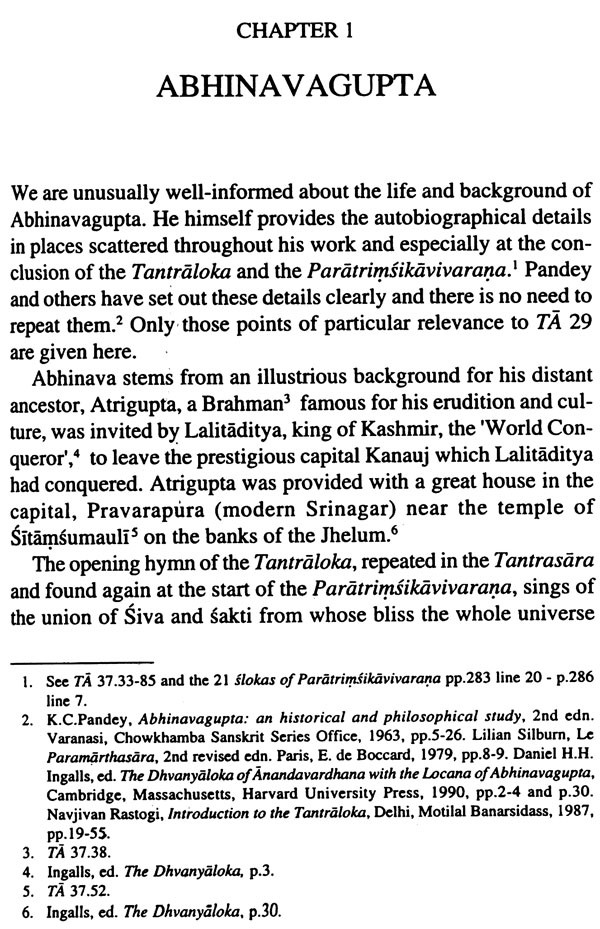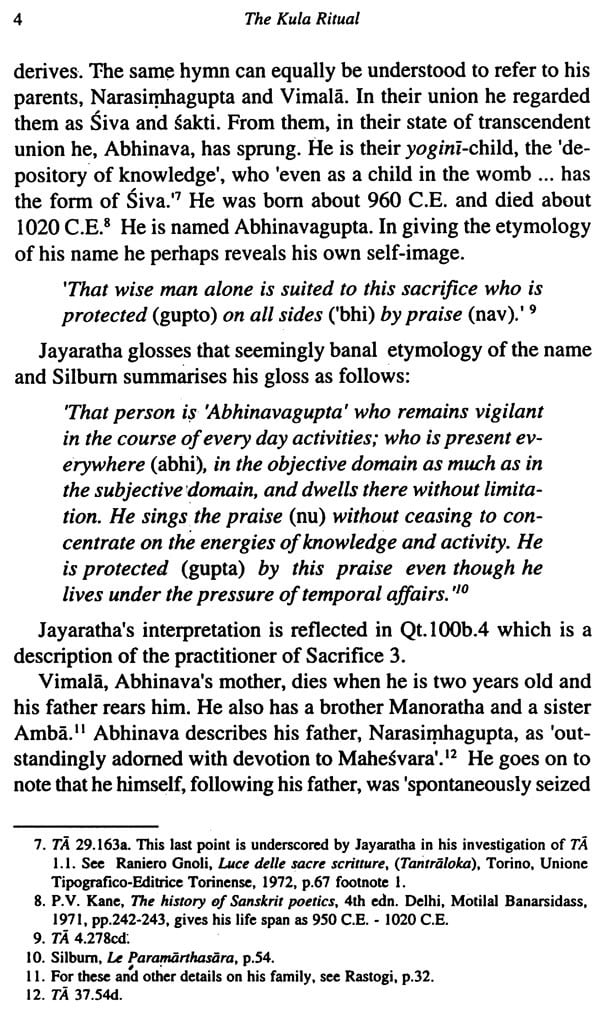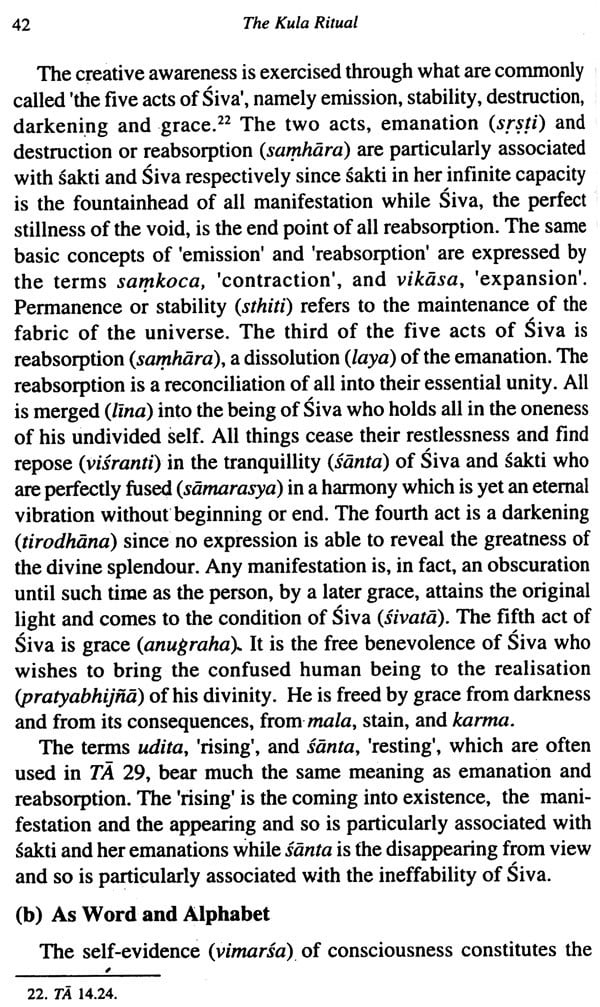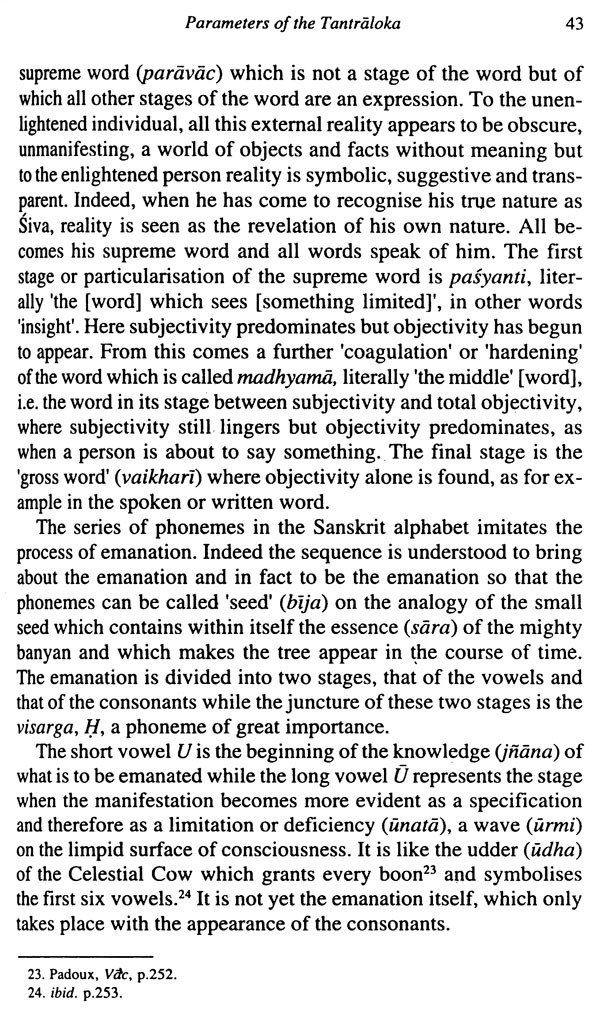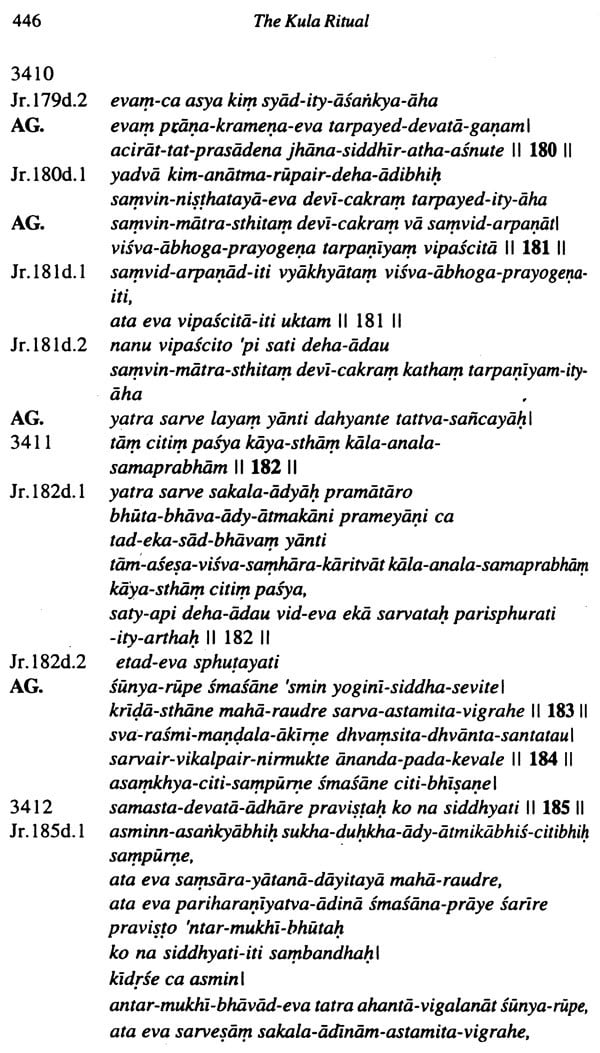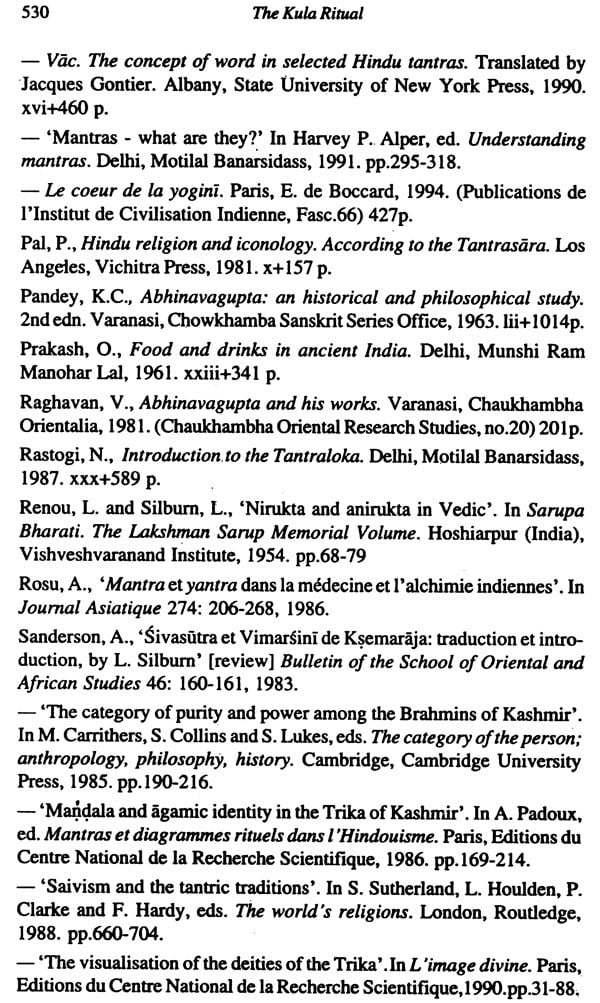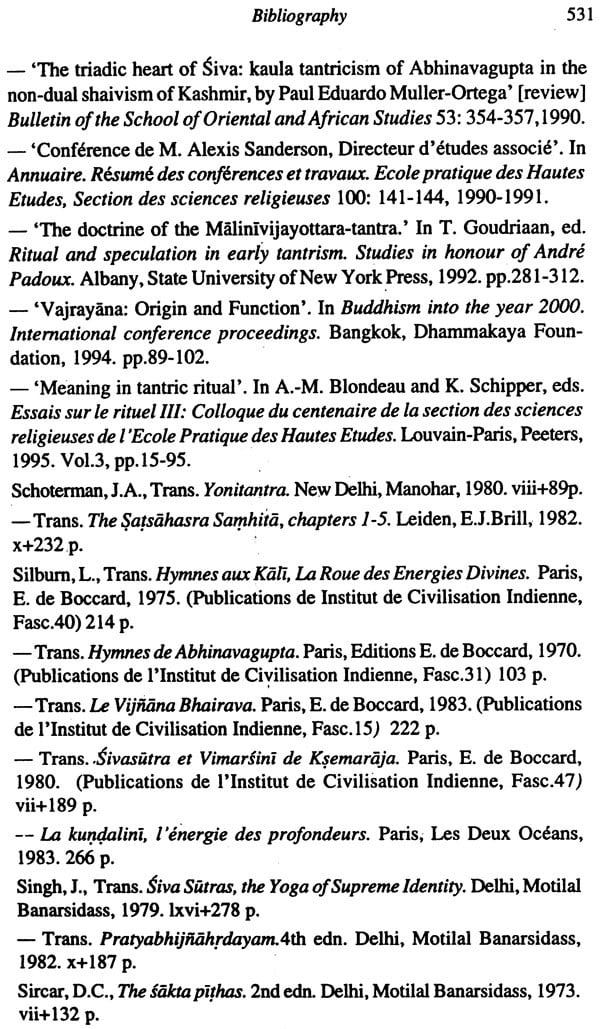
Abhinavagupta The Kula Ritual (As Elaborated in Chapter 29 of the Tantraloka)
Book Specification
| Item Code: | IDE047 |
| Author: | John R. Dupuche |
| Publisher: | MOTILAL BANARSIDASS PUBLISHERS PVT. LTD. |
| Edition: | 2006 |
| ISBN: | 8120819799 |
| Pages: | 547 |
| Cover: | Hardcover |
| Other Details | 9.0 inch X 6.0 inch |
Book Description
Abhinavagupta, a leading figure in Kashmir Saivism, is increasingly being recognized as one of the chief contributors to the evolution of Indian thought. In his encyclopaedic work, the Tantraloka, 'Light on the Tantras', he describes the various tantras of his day and places at their apex the most extreme of them, the Kula ritual, which proposes the use of wine and meat and intercourse with women of the lower castes.
Is Abhinavagupta's esteem of the Kula ritual just the shadow side of genius, an aberration best forgotten? This work is a translation - the first into English of any chapter of the Tantraloka of Abhinavagupa's version of the Kuala ritual. It also provides a translation - the first into any language - of Jayaratha's indispensable commentary. It shows the structure of the text, which is not a confused mass of codes and activities but is articulated as finely as an Indian temple. The translation is accompanied by a commentary, the appendices, including glossary and index of words.
The Kula ritual leads the practitioner to ever more exalted stages of the mantra finally to reach the highest level of consciousness, the experience of mantravyapti, the 'pervasion of the mantra'. The person who knows this pervasion knows that he is Bhairava. The supreme mantra of consciousness is none other than the mantra SAUH, the supreme goddess Para, which expresses both the supreme reality and all manifested reality. In this way Abhinavagupta breaks down the dualism between sacred and profane, ritual and ordinary life so that the Kula practitioner is liberated while alive, his every act is worship and his every word is mantra.
About the Author:
John R. Dupuche is a priest of the Catholic Archdiocese of Melbourne. He is a member of the Ecumenical and Interfaith Commission of the Archdiocese and chair of its interfaith sub-committee and is involved with the Muslim Catholic Working Party. He is a member of the Australian Commission of Monastic Interfaith Dialogue and a director of the East-West Meditation Foundation. He is Chair of the Victorian Council of Churches Faith and Order Commission and an Honorary Research Associate at the Centre for Studies in Religion and Theology at Monash University. He conducts retreats and meditations in addition to his usual pastoral responsibilities.
He is particularly interested in the interface between Christianity and Kashmir Saivism.
Excerpts from Reviews:
"This work does Provide us with the best detailed picture of the Kula world and its rituals that has been produced to date as that world reveals itself in this one chapter of the Tantraloka."
- Paul E. Muller-Ortega,
Prof. Of Religion, University of Rochester.
" Dupuche's work makes no doubt a substantial contribution to the study of the so-called Kashmir Saivism, and more generally to the study of Tantrism to which Kashmir Saivism belongs. The Kula tradition, as is well-known, forms one of the major components in Abhinava's synthesis of the various currents of Saiva tantra."
- Prof. Raffaele Torella,
Chair of Sanskrit, Dipartimento di Studi Orientali,
Universita di Roma 'La Sapienza', Rome
"Abhinavagupta's Tantraloka is one of the most important work on the spirituality, philosophy and ritual of Kashmir Saivism and a mine of Information on the Tantric traditions. So far only an Italian translation by R.Gnoli of the text without the commentary by Jayaratha has been published in 1972 and a French translation by Lillian Silburn and Andre Padoux of the first five chapters with comments and extracts from Jayaratha's Viveka (1998). No complete English translation of text and commentary has come out so far. Since Abhinavagupts's verses are very terse and often contain several levels of meaning, it is necessary to consult Jayarath's commentary for a complete understanding of the text, as far as possible."
"John R. Dupuche has undertaken a difficult and major work by selecting the most esoteric chapter 29 of the Tantraloka, containing the secret Kulayaga, for a complete translation and study "
- Prof. Bettina Baumer,
Institute of Religious Studies, University of Vienna
| Acknowledgements | vii | |||
| Preface | xiii | |||
| How to Read this Monograph | xiv | |||
Prolegomena To The Tantraloka And To Jayaratha's Investigation
| ||||
| Chapters | ||||
| 1. | Abhinavagupta | 3 | ||
| 2. | The History of the Tantric Tradition | 8 | ||
| a. | Other Traditions | 8 | ||
| b. | The Saiva Tantric Scriptural Traditions | 10 | ||
| c. | The Kula Reform | 15 | ||
| d. | Abhinava's Hierarchy of Traditions | 18 | ||
| e. | The Exegesis of the Saiva Tantric Traditions | 19 | ||
| 3. | The Tantraloka | 23 | ||
| a. | The Purpose of the Tantraloka | 23 | ||
| b. | Models of Composition | 24 | ||
| c. | Generalities on Style | 26 | ||
| d. | The Manuscript | 27 | ||
| 4. | Jayaratha | 29 | ||
| 5. | Parameters of the Tantraloka | 34 | ||
| 1. | The Absolute: | |||
| a. | As a Unitary Reality | 34 | ||
| b. | As a Mutuality | 36 | ||
| c. | As a Unity | 38 | ||
| 2. | The Emanation of the Absolute | 41 | ||
| a. | As a Contraction of Splendour | 41 | ||
| b. | As Word and Alphabet | 42 | ||
| c. | As Cosmology | 47 | ||
| d. | As the Human Being | 52 | ||
| 3. | Reabsorption of the Absolute | 55 | ||
| a. | Six Pathways | 56 | ||
| b. | Five Forms of Subtle-breath | 57 | ||
| c. | Seven Levels of Bliss | 58 | ||
| d. | Four Aspects of the Krama Cycle | 59 | ||
| e. | Five States of Consciousness | 60 | ||
| f. | Five Field of Knowledge | 61 | ||
| g. | Twelve Stages of Sound | 62 | ||
| h. | Four Means to Reach the Highest State | 64 | ||
| i. | Three Attitudes | 66 | ||
| 6. | Tantraloka 29 | 68 | ||
| a. | Structure of Tantraloka 29 | 68 | ||
| b. | General Topic "The Secret Ceremony' | 73 | ||
| c. | Sub-topic 1 'The Category 'qualified' | 75 | ||
| d. | Sub-topic 2 'The Kula Lineage of the Perfected Beings and Their Wives' | 79 | ||
| e. | Sub-topic 3 'The Ritual of Adoration' | 113 | ||
| f. | Sub-topic 4 'The Ritual with the Sexual Partner' | 124 | ||
| g. | Sub-topic 5 'The Ritual of the Secret Teaching' | 147 | ||
| h. | Sub-topic 6 'Initiation' | 150 | ||
| i. | Sub-topic 7 'Consecration' | 164 | ||
| j. | Sub-topic 8 'Penetration' | 166 | ||
| k. | Rites to Conclude the Initiation | 174 | ||
|
The Translation Of The Tantraloka 29 | ||||
| General Topic | The Secret Ceremony | 179 | |
| Sub-topic 1 | The Category 'qualified' | 179 | |
| Part I: The Rituals for the Initiated | 180 | ||
| Sub-topic 2 | The Kula Lineage of the Perfected Beings and their Wives | 180 | |
| Sub-topic 3 | The Ritual of Adoration | 218 | |
| Sub-topic 4 | The Ritual with the Sexual Partner | 240 | |
| Sub-topic 5 | The Ritual of the Secret Teaching | 294 | |
| Part II: The Rituals of Initiation | 302 | ||
| Sub-topic 6 | Initiation | 302 | |
| Sub-topic 7 | Consecration | 320 | |
| Sub-topic 8 | Penetration | 324 | |
| Rites to Conclude the Initiation | 343 | ||
| Appendices | ||
| 1. | The 36 Categories, the 5 Kala and the 4 Spheres | 349 |
| 2. | The Phonemes of Sabdarasi, Matrka and Malini and the Categories | 351 |
| 3. | The Uccara of OM | 353 |
| 4. | The Mantras | 354 |
| 5. | The Deities Named | 355 |
| 6. | The Perfected Beings etc. and their Lineages | 358 |
| 7. | The Installation of the Sacred Sites on the Body, According to TA 29.59-63 | 361 |
| 8. | The Schools and Systems Named | 362 |
| 9. | The Text Named in TA 29 and in Jayaratha's Investigation | 363 |
| 10. | Index of Quotations and their Source | 366 |
| 11. | The Places Mentioned in TA 29 and in Jayaratha's Investigation | 374 |
| 12. | The Mandala of the Kula Tradition | 378 |
| 13. | Sanskrit Text of Tantraloka 29 | 379 |
| 14. | Glossary of Terms and their Location within the Text | 471 |
| 15. | The Structure of TA 29 | 513 |
| Bibliography | 524 | |
 to all international destinations within 3 to 5 days, fully insured.
to all international destinations within 3 to 5 days, fully insured.Book's Contents and Sample Pages
